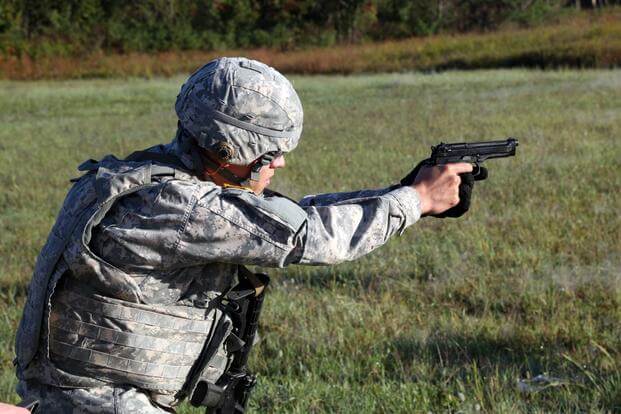Sen. John McCain is recommending at the U.S. Army throw out its current plan to replace the M9 service pistol until it can decide upon a specific caliber and type of ammunition soldiers need.
The chairman of the Senate Armed Services Committee blasted the Army's Modular Handgun System, or MHS, effort in the latest in his "America's Most Wanted: Indefensible" report series.
The Oct. 29 report criticizes the effort as a "costly misfire" and maintains that the Army has taken "10 years and wasted potentially tens of millions of dollars in order to purchase simple handguns." McCain says the Army needs to select the caliber it wants for a new sidearm before going any further with the effort.
Army formally launched its XM17 MHS competition to replace the M9 9mm pistol in late August by offering gun makers the chance to supply the service with a new pistol and the ammo to go with it.
"The Army plans to conduct ‘an open caliber competition,’ which means the choice of caliber is left up to the discretion of industry. But the caliber of the cartridge and the type of bullet it launches is arguably the most important performance component of the handgun," the report states.
"The Army should suspend or cancel the current [request for proposal] until it can conduct a caliber study to determine what caliber and cartridge is optimum for the next handgun to meet current and emerging threats."
Meanwhile, the Army maintains that it adopted the requirement for a new modular handgun from the Air Force in October 2013. In January 2014, based on validation that both requirements and adequate resources existed, the Army initiated the XM17 MHS program, according to a written response by Army spokesman Lt. Col. Jesse Stalder.
"The Modular Handgun System Acquisition Strategy has been designed to afford all potential vendors the maximum opportunity to submit multiple proposals, featuring both the handgun and ammunition, to promote consideration of a wide-range of available technologies," said Stalder.
"The Army has used the past 16 months to gather extensive market research and industry feedback before releasing the final RFP. Many small arms vendors had requested an iterative and deliberate process featuring multiple industry days and draft RFPs in order to give the Army feedback on MHS requirements and the competition."
One of the major goals of the MHS effort is to adopt a pistol chambered for a more potent round than the current 9mm, weapons officials said. The U.S. military replaced the .45 caliber 1911 pistol with the M9 in 1985 and began using the 9mm NATO round at that time.
MHS is set to cost at least $350 million and potentially millions more if it results in the selection of a more potent pistol caliber, sources said.
The competition will also evaluate expanding or fragmenting ammunition, such as hollow-point bullets, that have been used by law enforcement agencies for years. Earlier this summer, the Army's draft solicitation cited a new Defense Department policy that allows for the use of "special purpose ammunition."
The winner will have to be able to deliver 6,300 full-size pistols per month within a year and 3,000 compact pistols per month with in a year, according to the RFP.
The winning contractor will have to be able to ramp up to delivering 2.8 million rounds of ball ammunition per month within three years and 1.6 million rounds of special-purpose ammunition per month within three years, according the RFP.
"One of the principles of a commercial-off-the-shelf acquisition is that the government must be clear on what it is seeking to buy. This lack of clarity will likely result in top handgun makers not competing as many of them are not large defense contractors, which means that our soldiers won't necessarily get the best handgun that commercial industry has to offer," the report states.
"Or perhaps that's the whole point, and the Army already has a preferred outcome in mind and is just going through the motions with this 'competition.' By purchasing both handguns and ammunition from a single vendor on a single contract, the total value of which could exceed $1.2B, the Army's selection process favors larger companies over smaller ones and increases the risk that the Army will not select the best performing weapon, ammunition, silencer, holster and training system components available."
Current plans call for the Army to purchase more than 280,000 full-size handguns and 7,000 compact versions, Army officials maintain. The other military services participating in the MHS program may order an additional 212,000 systems above the Army quantity.
As an alternative, McCain suggests that Army units be allowed to choose their own handguns as long as they are already in the inventory.
"The easiest solution would be to allow Army divisions or even brigade combat teams to select from handguns, ammunition and accessories that are already tested, approved and are being used in combat by units within the U.S. Special Operations Command and the Joint Special Operations Command," according to the report.
"The relatively low unit price and low quantity of issue at the brigade and division level would save many millions in acquisition costs and bureaucracy and get new handguns to the troops three years earlier than the current plan. The Army already does this for eyewear through the Authorized Protective Eyewear List (APEL) where lower level Army units can order from over thirty different types of commercial protective eyeglasses."
--Matthew Cox can be reached at matthew.cox@military.com.



























